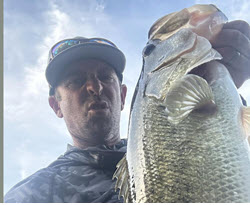
Bank fishing, or bank angling as I like to call it, is one of my favorite fishing styles. Let’s get into it and break down the basics you need to become a successful bank angler. Bank fishing holds a special place in my heart because that’s how I started, and I still love the simplicity and connection to nature it provides. So, let’s dive into Bank Fishing 101 and get you ready to catch some bass from the shore!

First up, let’s talk about being an efficient, mobile angler. When you’re bank fishing, you want to carry enough gear to be prepared but not so much that it bogs you down. Remember, unlike fishing from a boat, you need to walk, climb, and maneuver to find the best spots. A good strategy is to use a backpack or a sling bag to keep your hands free and your gear accessible. I often use a Flambeau backpack because it’s designed with all the compartments and durability you need for a day on the bank. It’s important to choose a storage system that works for you, allowing easy access to your tackle and keeping everything organized.

Now, what should you carry in your bag? Think essentials; in my backpack, I always have scissors, pliers, scent, spike-it dyes, leader material, sunscreen, and sunglasses. These basics ensure I’m ready for any situation. For tackle, I use smaller boxes to organize my lures, which helps keep my gear light and manageable. For example, my frog box has just enough of my favorite frogs in basic colors to cover any situation. You don’t need dozens of each lure; just a few reliable ones in versatile colors.

Next, let’s talk rods and reels. As a bank angler, you can’t carry ten different rods, so you need to be strategic. I recommend two rods: a spinning rod and a casting rod. For the spinning rod, go with a 7 to 7.5-foot medium action rod paired with a 30 or 40 size spinning reel. This setup is perfect for finesse techniques like drop shots, wacky rigs, and Ned rigs. Use braided line with a fluorocarbon leader to give you versatility and strength. The larger reel size helps with long casts, which are often necessary when fishing from the bank.

For the casting rod, choose a 7 to 7.5-foot medium heavy action rod with a high gear ratio reel (at least 7:1). This setup handles your power fishing techniques, such as jigs, frogs, and larger swimbaits. Like the spinning setup, use braided line with a fluorocarbon leader. This allows you to adapt quickly to different cover and conditions by simply changing the leader.

The final part of becoming an efficient bank angler is having lures to cover the top, middle, and bottom of the water column. Your tackle should include a mix of hard baits and soft plastics. For topwater, carry a few walking baits, poppers, and frogs. For the middle zone, include jerkbaits, spinnerbaits, and crankbaits. And for the bottom, have some jigs, Texas rigs, and Carolina rigs ready to go. Keep your selection simple: a few lures in basic colors will cover most situations. For example, something white or pearl, a green pumpkin and black blue soft stick bait can be fished in multiple ways across different depths.
Remember, bank fishing is about mobility and adaptability. Use your backpack to keep everything organized and easily accessible. Stick to a streamlined selection of rods, reels, and lures, and focus on covering the different zones of the water column. This approach will make you a more efficient and effective bank angler.
_________________________________
____________________________________
Like Ike on Facebook, and follow him on Instagram and TikTok for fishing and fun content.
Subscribe to Mike’s YouTube channel, to ensure you see every adventure video. (Download the YouTube app on your phone and the videos will come to you automatically.)
















